


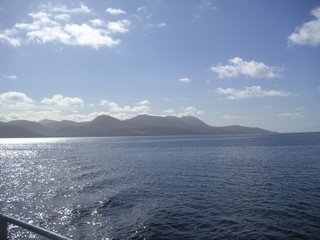
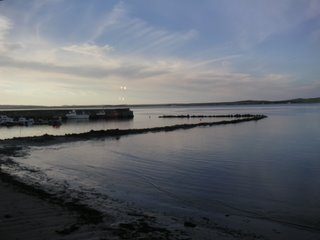


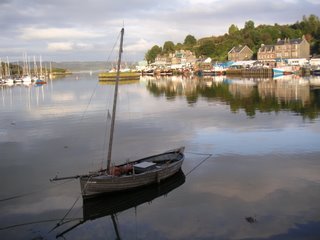
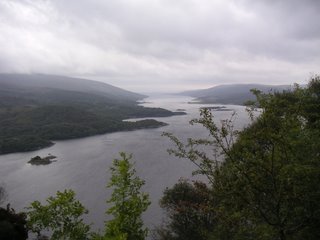

Just a place to post experiences, comments and information. Nothing profound really....










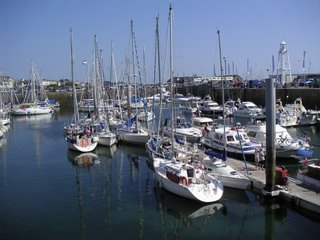

 View over Braye Harbour
View over Braye Harbour
After a quick pint on the deck of the recently refurbished Divers pub we walked to the town finding a very nice but packed Thai restaurant. What an incongruous sight on Alderney! Next morning after a walk up to the town to get a battery for the ships clock we set out for Guernsey down the dreaded Swinge in a fickle sea mist.
That dreaded Swinge
For those who don't know it The Swinge is a rock strewn channel down the North West side of Alderney. When the tide is flowing at full pelt its a scary place for a sailing boat. With 5 knots of tide or more under your keel you have to keep your wits about you. This sea mist was unusual in August and was quite scary.
On then to Guernsey which was similarly shrouded in a mist that came down in seconds and obscured the many rocks in the Little Russell aproach channel. We were glad of the radar and GPS which guided us safely into harbour. Later the mist lifted, leaving a nice sunny evening. After a shower and the inevitable G&T mixed on board, we repaired to a nice Italian hostelry and the yacht club for a nightcap.Next day one of the crew had to leave us, so we all got on the 'round the island' bus which passed the airport. The driver refused my mainland pensioners' bus pass, it was only 60p anyway! We spent the afternoon shopping, had an early evening meal for about a tenner at the amazing French owned Petit Bistro and it was early to bed for an early start back to Alderney. On arrival we set off to walk to the south of the Island taking us past the Swinge again studded with rocks at low tide. We continued round to the south where we could see the Gannet colony. Every flat space on the guano covered rocks was occupied by gannets, whilst as many again wheeled overhead in a massive cloud.
The Swinge at low tide with Ortac and the Casquettes light in the background

The gannet colony
Then on to Telegraph bay, the only other yacht friendly place in Alderney. A magnificent view on such a wonderful sunny day. This bay is a refuge from the Alderney Race which has even faster tidal streams that The Swinge. The tides in this area have one of the greatest tidal ranges in the world, exceeded only by Newfoundland. This means that in a yacht which can make only 5 to 6 knots you have to go with the tides, otherwise you can easily end up going backwards or risk ending up on the rocks.
At one place there was heather on the cliffs, at another a carpet of succulents with orange flowers. The flora of Alderney is like the island itself, miniature and truly amazing.
 Telegraph Bay
Telegraph Bay
Then back to St Annes, Alderneys' metropolis for a well earned late afternoon pint at the Divers.

Enjoying a pint in The Divers
Next day the plan was to head for Cherbourg, but with the wind in an awkward place the day after offering the prospect of having to tack our way back across the channel we set course for the Needles on a nice reach. Our sail was in a force 5, which increased as we approached the Island to a full 6. Musketeer romped along and we did Braye harbour entrance to the Needles in 9 hours dead, a record for us as its about 55 miles, and a pretty good time for any 30 foot yacht. The wind and sea condition were too much for an autohelm (it was broken anyway), and the last few hours were very tiring with only two helmsman. We entered the Needles channel a little early with the tide still ripping out against us past the Bridge buoy and the Shingles bank (the doom of many a yacht), a mass of foaming white overfalls just 50 metres way. One of those anxious moments. But we made it easily in spite of the foul tide.

Approaching the Needles
We tied up in Yarmouth, one of my favourite places in the Solent. After a welcome shower it was off to the Wheatsheaf, a real gem of a hostelry with excellent food and beer, and then off to the inevitable yacht club for that nightcap.
The next morning we headed down the Solent towards Cowes, but we continued to Wooton Creek where we met up with an old friend at the Royal Victoria yacht club . The Royal Vic was actually started by the Queen and her consort because Albert was not a naval man and therefore not allowed to join the Island's most prestigious yacht club, the white ensigned Royal Yacht Squadron.
That night in Cowes was the day of the mass terrorist arrests all over the mainland. As we sat in Murrays restaurant we observed two policeman armed with machine guns walk along Cowes High Street. Quite a shock in a town where the only disturbance is the group of youngsters gathered outside the chip shop. My companion relieved the tension by saying that the armed police were there 'on account of someone trying to get into the Royal Yacht Squadron without a tie!'
The next afternoon we were back out our berth in the Hamble. Our missing companion arrived to collect his gear. After tidying the boat, we sat quietly enjoying a cup of tea, recalling the events of the week. Although we have done this trip and others like it many times together ,we discussed the best moments. The new sights we had seen, things we marvelled at like Aderneys' stange flora, laughed at the sleepless night in Braye harbour where on every yacht people were up hour on hour trying to prevent boats crashing together even though there was no east wind. At last we reluctantly parted leaving our old boat quiet on its mooring...


This picture gives a clue, the weeds on the many untended plots are shoulder high and what you can't see just yet is that the soil is really stony and very free draining. On the upper plots where my patch is, there is poor soil that, in its initial state, is pretty unproductive. A local geologist reckons that this land was once a stream bed, even though its altitude is approximately 300 feet on the edge of the Chilterns. Added to that there is the wildlife.... 20 years ago I had a plot here, packed with plants growing strongly, then one day I came along and it had been raised to the ground by a huge flock of pigeons. I gave up! But now I have retired there is a little more time for vegetable growing. We have Muntjack and other deer, rabbits, pigeons and pheasants, and they are all after your crops.These days on this site we all garden in chicken wire enclosures to thwart the rabbits and discourage the deer. Anything the birdies like must be kept under fruit nets.
Here's my plot, 20 yards by 10, with uncultivated plots with shoulder high weeds on either side, and brambles and elderberry at the rear. In high summer I shall be picking those berries all of which make excellent pies.
As you can see, I'm not a fussy allotmenteer - there are plenty of weeds. Its not my whole life. I probably do no more than three hours a week leaving plenty of time for other essential retirement activities like getting up late, reading the paper, sailing, jetting off on bargain Easyjet breaks, sitting in the garden, having lazy pub lunches and walking or riding my bike in the local countryside. Just lately I have ripped my kitchen out and replaced it, so the resulting allotment neglect has ensured that weeds have really sprouted. I am a lazy gardener so my technique is to rip them up with my hoe and leave them on top to die, providing a nice mulch here and there. Personally I like to dig very little so an initial annual dose of Roundup from my 5 litre sprayer deals with the weeds. The rest is removed by muscle power over the seasons. I use no artificial fertiliser or pest control sprays.

This is the non cultivated part of the plot with my compost bins, home made cloche (made from old conservatory roofing sheets and now being used as a tool store), a water butt, and a small pile of really excellent horse manure. Note the weeds! All kitchen waste, garden rubbish and some weeds and plant tops from the plot get composted. But as the plot is fairly exposed its hard to get things to compost fast. We get excellent manure here, although expensive at £40 for a large heap. 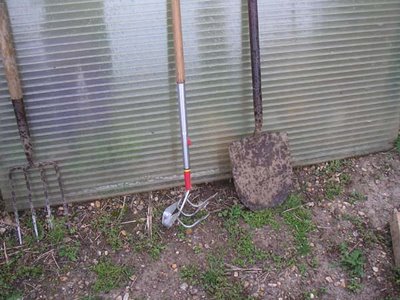 Iron hard ground full of stones calls for the right tools. Here's my Welsh miners pointed shovel with a steel shaft, and my Wolf hoe and weed loosener, a great tool.
Iron hard ground full of stones calls for the right tools. Here's my Welsh miners pointed shovel with a steel shaft, and my Wolf hoe and weed loosener, a great tool.
The plot costs me £12 a year, and for that you just get use of the plot and water (30 metres away), but nothing else. Fair enough really. Fencing and netting is an initial £100 outlay. The allotments are out in the country with fields and woods all around. Whilst you are toiling you can hear the larks singing constantly, the calls of South Oxfordshire's red kites wheeling overhead and pheasants screeching.
Heres some sweetcorn tomatoes and peppers. The Tomatoes are Marmande I got the seeds from France last year. Both the peppers and tomatoes are surplus plants to the real McCoy in our greenhouse at home. In our village we have a real old fashioned Ironmongers who sells great cheap plants too, the sweetcorn and courgette plants came from him. I brought a couple of screw eyes for a curtain from him the other day - 7p each instead of a packet at £4.50 from B&Q! Old fashioned customs, like splitting packets are often the best.

 Courgettes, Ridge Cucumbers and a little Butternut Squash plant. All on manure heaps. One day last year we had 14 cucumbers!
Courgettes, Ridge Cucumbers and a little Butternut Squash plant. All on manure heaps. One day last year we had 14 cucumbers! Runners French and Broad Beans. All on manure and mulched with more manure. When first planted out it was necessary to water these every evening. Since we are under hosepipe restrictions I had to do that by hand. Simultaneously I used the hose to fill the barrel. I don't believe in hosepipes because plants continuously watered with hoses don't grow decent root systems. As we only got 1 day of rain here in June I did water the beans every 3 to 5 days.
Runners French and Broad Beans. All on manure and mulched with more manure. When first planted out it was necessary to water these every evening. Since we are under hosepipe restrictions I had to do that by hand. Simultaneously I used the hose to fill the barrel. I don't believe in hosepipes because plants continuously watered with hoses don't grow decent root systems. As we only got 1 day of rain here in June I did water the beans every 3 to 5 days. 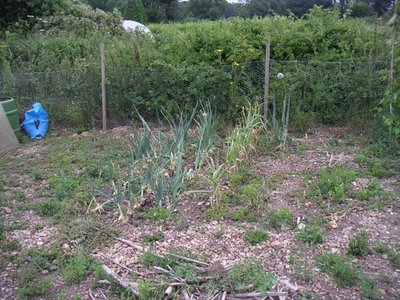 Onions, shallots and garlic do just great here.
Onions, shallots and garlic do just great here.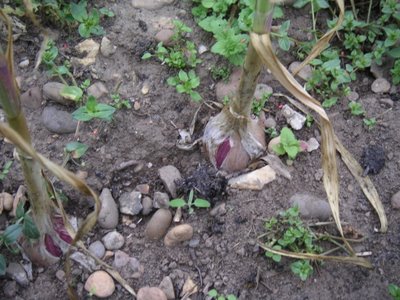 Here's a closeup of a 2 inch garlic bulb. I bought two bulbs for seed for 10p each from an Indian Grocer on Reading's Oxford Road and planted the cloves in early April. Almost ready....
Here's a closeup of a 2 inch garlic bulb. I bought two bulbs for seed for 10p each from an Indian Grocer on Reading's Oxford Road and planted the cloves in early April. Almost ready....
 The spuds, Arran Pilot, Foremost, Maris Peer and Desiree. I watered about the first three Arran Pilot's during the drought which resulted in a good initial crop. I have tried not earthing up a few Maris Peer and Desiree to see if this affects the yield. Why dig if you don't have to?
The spuds, Arran Pilot, Foremost, Maris Peer and Desiree. I watered about the first three Arran Pilot's during the drought which resulted in a good initial crop. I have tried not earthing up a few Maris Peer and Desiree to see if this affects the yield. Why dig if you don't have to?
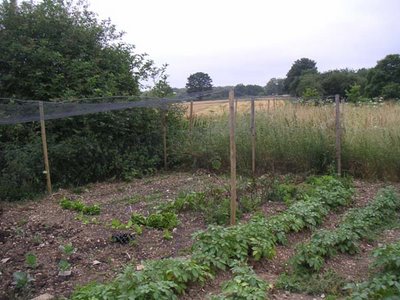 'The cage'. Necessary for any tasty crops. Therefore seed beds, strawberries, brassicae, lettuce and anything else tender goes in here. Last week I found two live pigeons in there. They ate all my baby cabbages, leaving the calibrese (choosy!), so I ate them. They tasted nice in a pie!
'The cage'. Necessary for any tasty crops. Therefore seed beds, strawberries, brassicae, lettuce and anything else tender goes in here. Last week I found two live pigeons in there. They ate all my baby cabbages, leaving the calibrese (choosy!), so I ate them. They tasted nice in a pie!

Heres the payoff, collected today. A couple of the first courgettes, some beetroot, shallots, runner beans and a root of Arran Pilot. This evening's dinner and fresh baby beets for tommorow's salad.
There are a lot of plots on our site free, covered in dense untended weeds. This can be explained by the natural obstacles I have described. As you can see mine is not the neatest plot in the world. I find that a couple of 1 1/2 hour sessions a week is all that is needed to grow what my pal Val and I need. There are some at our site that have the weed free regimented plots. However the vast majority are like mine, practical plots producing tasty vegetables in sub-optimum yields. There is no allotment committee, no allotment inspectors, no one enforcing any rules, and nature is your only companion.
It's perfect really.